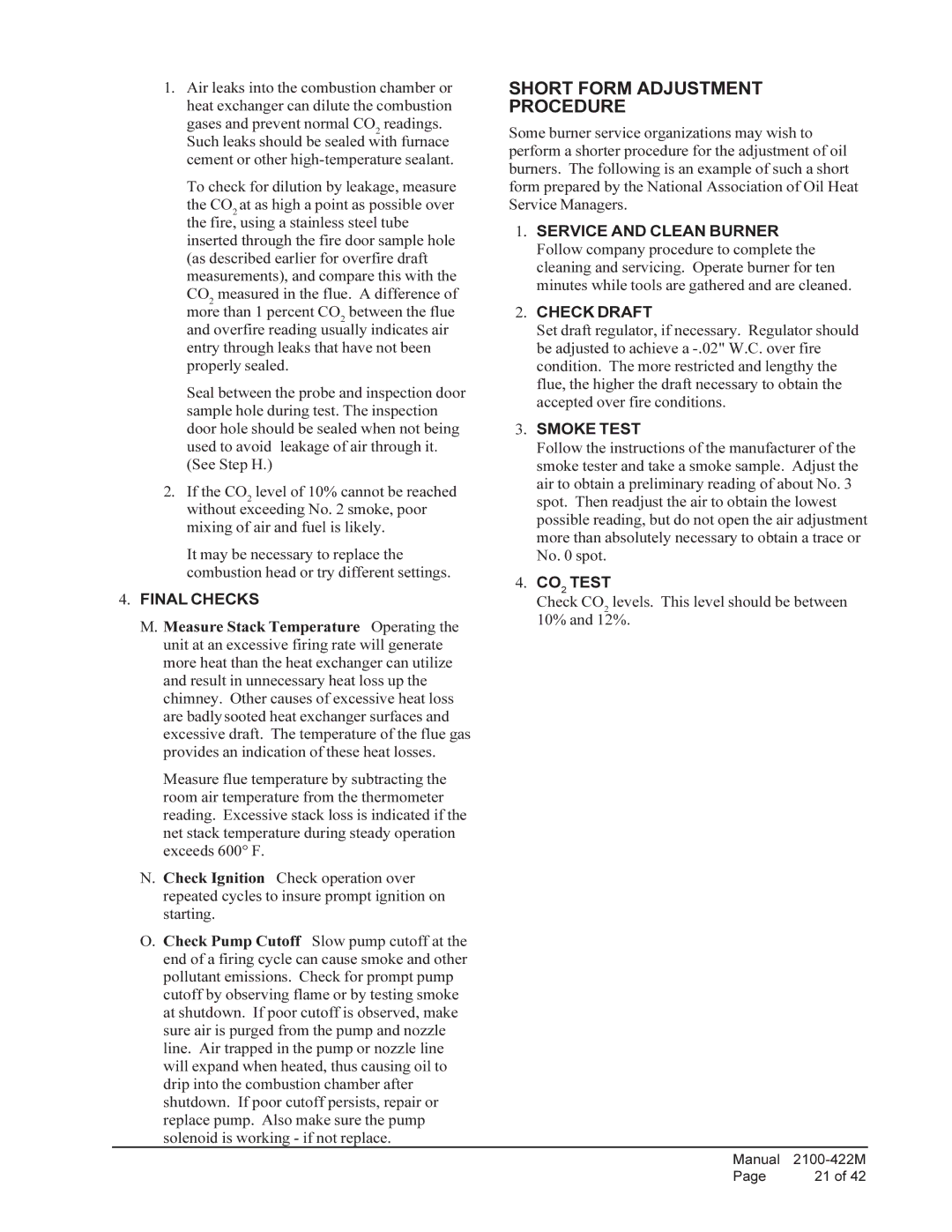1.Air leaks into the combustion chamber or heat exchanger can dilute the combustion
gases and prevent normal CO2 readings. Such leaks should be sealed with furnace cement or other
To check for dilution by leakage, measure
the CO2 at as high a point as possible over the fire, using a stainless steel tube inserted through the fire door sample hole (as described earlier for overfire draft measurements), and compare this with the
CO2 measured in the flue. A difference of more than 1 percent CO2 between the flue and overfire reading usually indicates air entry through leaks that have not been properly sealed.
Seal between the probe and inspection door sample hole during test. The inspection door hole should be sealed when not being used to avoid leakage of air through it. (See Step H.)
2.If the CO2 level of 10% cannot be reached without exceeding No. 2 smoke, poor mixing of air and fuel is likely.
It may be necessary to replace the combustion head or try different settings.
4.FINAL CHECKS
M.Measure Stack Temperature Operating the unit at an excessive firing rate will generate more heat than the heat exchanger can utilize and result in unnecessary heat loss up the chimney. Other causes of excessive heat loss are badlysooted heat exchanger surfaces and excessive draft. The temperature of the flue gas provides an indication of these heat losses.
Measure flue temperature by subtracting the room air temperature from the thermometer reading. Excessive stack loss is indicated if the net stack temperature during steady operation exceeds 600° F.
N.Check Ignition Check operation over repeated cycles to insure prompt ignition on starting.
O.Check Pump Cutoff Slow pump cutoff at the end of a firing cycle can cause smoke and other pollutant emissions. Check for prompt pump cutoff by observing flame or by testing smoke at shutdown. If poor cutoff is observed, make sure air is purged from the pump and nozzle line. Air trapped in the pump or nozzle line will expand when heated, thus causing oil to drip into the combustion chamber after shutdown. If poor cutoff persists, repair or replace pump. Also make sure the pump solenoid is working - if not replace.
SHORT FORM ADJUSTMENT
PROCEDURE
Some burner service organizations may wish to perform a shorter procedure for the adjustment of oil burners. The following is an example of such a short form prepared by the National Association of Oil Heat Service Managers.
1.SERVICE AND CLEAN BURNER
Follow company procedure to complete the cleaning and servicing. Operate burner for ten minutes while tools are gathered and are cleaned.
2.CHECK DRAFT
Set draft regulator, if necessary. Regulator should be adjusted to achieve a
3.SMOKE TEST
Follow the instructions of the manufacturer of the smoke tester and take a smoke sample. Adjust the air to obtain a preliminary reading of about No. 3 spot. Then readjust the air to obtain the lowest possible reading, but do not open the air adjustment more than absolutely necessary to obtain a trace or No. 0 spot.
4.CO2 TEST
Check CO2 levels. This level should be between 10% and 12%.
Manual | |
Page | 21 of 42 |
